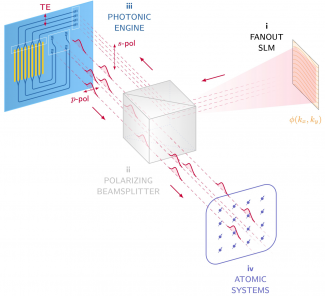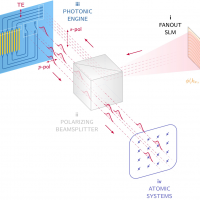News
Photonic Circuits to Program Atoms at Scale
How do we control large numbers of qubits? This is a question being asked across quantum information science, including for atomic qubits. Unlike other varieties of qubits—such as superconducting qubits, where control signals are primarily electrical—atomic qubits are controlled by beams of light. Individual control over each atomic qubit requires modulating many individual optical beams. This leads to advantages and challenges. Optical links do not require a physical wired connection, meaning that all the control wiring can be effectively moved away from the delicate qubits, and instead projected onto the qubits via a microscope. However, the requirements are stringent: these control optics need to modulate more than a million times faster than a conventional liquid crystal display, and be able to control a special spectrally-pure type of light (coherent light) that atomic systems require.
In this work, the group of Prof. Englund at MIT developed a new display architecture for fast optical control based on scalable nanophotonic modulators. The team demonstrated this architecture with a 4 pixel x 4 pixel prototype to individually address sixteen silicon-vacancy artificial atoms in diamond. Critically, the architecture includes self-calibrating knobs to stabilize each modulator to balance power between channels and to spatially and spectrally steer output beams. In active collaborations with atomic physicists, the team aims to control hundreds of ultracold atoms to pave the road to programmable quantum simulators and computers.

Figure: i) a spatial light modulator (SLM) is used to create a hologram of beams. ii) After reflecting off a polarizing beamsplitter, the light in these beams iii) couples into a nanophotonic circuit, passes through individual amplitude modulators, and couples out into the orthogonal polarization. This light passes through the beamsplitter, iv) toward the desired atomic systems.
